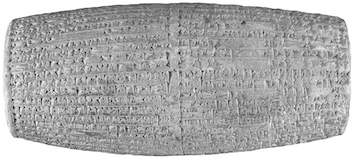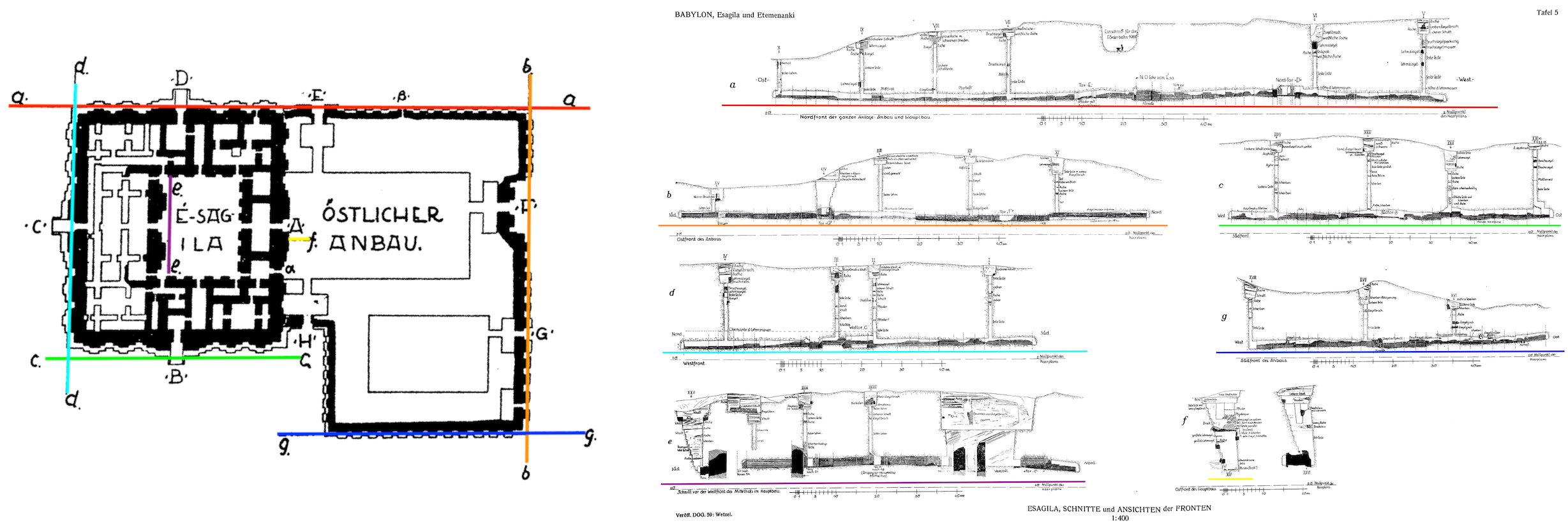Ka-Utu-e, Ka-Lamma-arabi, Ka-hegal, and Ka-ude-babbar (gates of the main building of Esagil at Babylon)

The four principal gates of Esagil's main building were Ka-Utu-e, Ka-Lamma-arabi, Ka-hegal, and Ka-ude-babbar. It is abundantly clear from available textual sources that Ka-Utu-e was located in the eastern façade and gave access to the Court of Bēl from the courtyard of the eastern annex building; that Ka-Lamma-arabi was the northern entrance into the temple's main building; that Ka-hegal was the main gate of the western façade; and that Ka-ude-babbar was the southern entrance into Esagil's main building. Respectively, these four gates are to be identified with Gates A, B, C, and D, all of which were excavated by Friedrich Wetzel and Klaus Müller in 1910–11 on behalf of the Deutsche Orient-Gesellschaft (DOG) and Königliche Museen Berlin (KMB).
Names and Spellings
The Sumerian ceremonial names of these four gates of Esagil mean "Gate of the Rising Sun (Ka-Utu-e), "Gate of the ... Protective Spirit" (Ka-Lamma-arabi), "Gate of Abundance" (Ka-hegal), and "Gate of Dazzling Wonder" (Ka-ude-babbar). Ka-Lamma-arabi also went by the name "Gate of Bēltīya" (Akkadian bāb bēltīya) because that entrance was adjacent to the main part of Esagil that was dedicated to the complex of rooms associated with the goddess Zarpanitu's cella (Edara'ana) in the as-of-yet unexcavated northwestern corner of Marduk's temple.
- Written Forms: KA₂ dGAŠAN-ia; ka₂-he₂-gal; ka₂-he₂-gal₂; ka₂-dlamma-a-ra-bi; ka₂-dlamma-ar-ra-bi; ka₂-dlamma-ra-bi; ka₂-u₆-de-babbar; ka₂-u₆-de-babbar-ra; ka₂-dUTU-e₂-babbar-ra; ka₂-dutu-e₃; ka₂-dutu-e₃-a.
Known Builders

Loan Ant-43, a two-column clay cylinder purchased at Babylon by Sir John Malcolm ca. 1811 and now on display in the Fitzwilliam Museum in Cambridge. The Akkadian inscription written on it records the manufacture of copper mušhuššu-dragons for a few prominent gateways of Marduk's temple Esagil. Credit: Fitzwilliam Museum.
- Neo-Babylonian (ca. 625–539 BC)
- Neriglissar (r. 559–556 BC)
- Nabonidus (r. 555–539 BC)
Building History
During his short, three-year reign, Neriglissar — an influential and wealthy landowner who married one of Nebuchadnezzar II's daughters (possibly Kaššaya) and later became king — sponsored renovation on parts of Marduk's temple. An Akkadian inscription of his written on clay cylinders records that he had stationed statues of mušhuššu-dragons in all four entrances of Esagil's main building. The relevant passage of the "Royal Palace Inscription" reads:
The mušhuššu-dragon, the "snake-dragon," was the animal that most often represented Babylon's patron god Marduk. These were also represented on the glazed-brick façade of the Ištar Gate, the most important gate of the inner city of Babylon.
Nabonidus states that he clad the wooden doors of the Gate of Bēltīya (= Ka-Lamma-arabi) with silver. Presumably, this was a continuation of the work begun under Nerilgissar.
Archaeological Remains
The remains of the four external gates of Esagil's main building, which are buried deep under modern Tell Amran, were exposed in trenches (a, c, d, and f) dug under the direction of Friedrich Wetzel and Klaus Müller in 1910–11. Like the rest of the temple's exterior walls, Ka-Utu-e, Ka-Lamma-arabi, Ka-hegal, and Ka-ude-babbar were all constructed of unbaked bricks. These four gates were positioned in the center of the façades. The walls on both sides of each entranceway had three stepped layers of pilasters, which gave them an intricate, tower-like appearance. This architectural style is not presently attested for any of the other temples excavated at Babylon. The entrances of the gates are between 4.6 and 4.85 m wide.

Annotated plans of Esagil showing the pits and trenches dug into and around Esagil in 1910–11. Adapted from F. Wetzel, Das Hauptheiligtum des Marduk in Babylon, Esagila und Etemenanki pls. 2 and 5.
The copper(-plated and inscribed) mušhuššu-dragons that Neriglissar stationed in Ka-Utu-e, Ka-Lamma-arabi, Ka-hegal, and Ka-ude-babbar, however, did not stand the test of time. This is not unexpected since the metal used to fashion them was undoubtedly reused when Esagil fell on hard times.
Further Reading
- George, A.R. 1992. Babylonian Topographical Texts (Orientalia Lovaniensia Analecta 40), Leuven, pp. 83–91 and 391–393.
- Pedersén, O. 2021. Babylon: The Great City, Münster, pp. 143 and 152.
- Wetzel, F. 1938. Das Hauptheiligtum des Marduk in Babylon, Esagila und Etemenanki (Wissenschaftliche Veröffentlichung der Deutschen Orient-Gesellschaft 59), Leipzig, 4–7 and pls. 3–5.
Banner image: areal photograph of the excavation pits and trenches in the area of the remains of Esagil and Etemenanki taken in 1923 (left); a reconstruction of Esagil and Etemenanki during the reign of the Neo-Babylonian king Nebuchadnezzar II (center); a plan of Esagil, and Etemenanki (right). Images from O. Pedersén, Babylon: The Great City, pp. 144–145 figs. 4.3–4.4 and p. 151 fig. 4.11.
Jamie Novotny
Jamie Novotny, 'Ka-Utu-e, Ka-Lamma-arabi, Ka-hegal, and Ka-ude-babbar (gates of the main building of Esagil at Babylon)', Babylonian Temples and Monumental Architecture online (BTMAo), The BTMAo Project, a sub-project of MOCCI, [http://oracc.org/btmao/Babylon/TemplesandZiggurat/Esagil/RoomsandGates/Ka-Utu-e/]